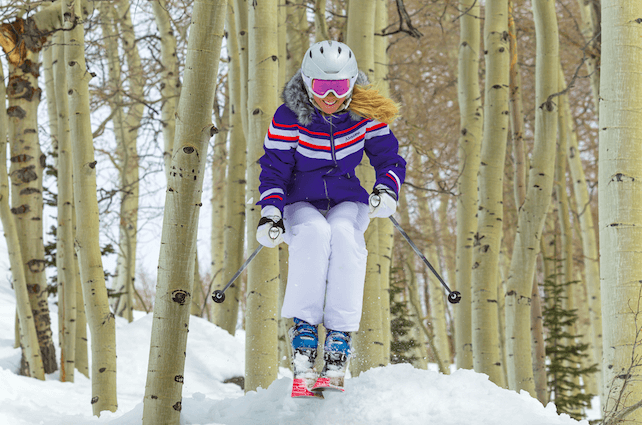
Nick Morgan, founder of Huddersfield-based chalet specialist, Le Ski, knows his right hand from his left. After 34 years in the business and on the mountain, he ought to. Nick was just 21 when he took a healthy slice of down-to-earth Yorkshire common sense to the chalet market in Courchevel, La Tania, and Val d’Isere.
Interested in what to wear skiing – read our guide here.
We’ve all done it: left our favourite gloves in the chalet, the bubble or a restaurant. And, without them, skiing just one run – even on a spring day – can be pretty miserable. That’s one reason why I now always carry a spare pair of ski gloves with me. And then there’s that moment when the one of the kids looks at you and says: “You have got my gloves haven’t you, Dad?”
You can get perfectly usable ski kit at all sorts of outlets nowadays, making the sport more accessible – which is fantastic. But one thing you shouldn’t skimp on is a decent pair of ski gloves. Cold hands will quickly drain the pleasure from your skiing day, and will affect your concentration, too. After all, who can think about the next turn when they’re dreaming of a hot chocolate with rum in the nearest mountain restaurant?
Personally I use two types, depending on the weather. For all the high Alpine mid-winter days I use a pair of Hestra leather gloves I call my ‘Spocks’ – they are mittens with one (index) finger. They’re extremely warm and weatherproof, but the extra finger means you can do your zip up or adjust your goggles even in the most horrible conditions.
In warmer parts of the season and for skinning I use an ancient and exhausted pair of Black Diamonds. They’re really comfortable in athletic conditions. They’re not so good when they get wet, but at least they don’t get overheated and sticky.
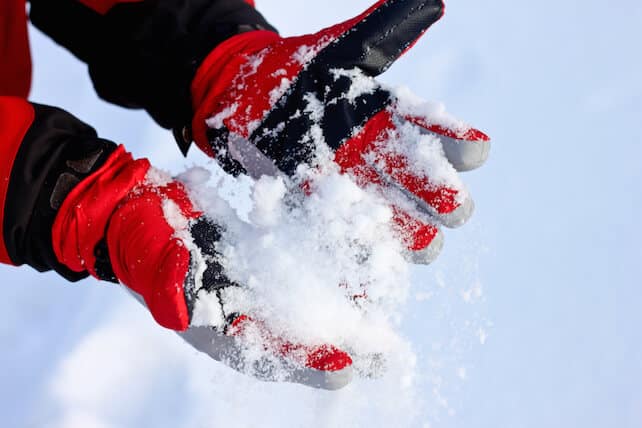
We once skinned to the top of a 4000 metre col high above Zermatt where I planted my poles in the snow, put my Black Diamonds on the grips as usual and proceeded to take off my skins. I turned round to see one pole slowly fall over in the wind and return 50 vertical metres back down the steep mountain we’d just skinned up! Oh how we laughed?! Well my friends did anyway…
Anyway, whether you’re beginner or a weathered skier or boarder, you’ll find that a good pair of ski gloves or mittens is one of the most essential pieces of kit in your mountain wardrobe.
Gloves need to be waterproof, able to withstand some very hard use on the slopes and, at the same time, they’ve got to keep your fingers nice and warm.
Apart from getting the right hand gear, there are other things you can do to fight the elements. If your core temperature is comfortable, it follows that your extremities will stay warmer, too.
Wear a down jacket or a technical mid-layer and base layer, do some warm-up exercises when you start skiing, stop off in a restaurant for a hot drink when you’re cold, tuck your hands under your armpits to warm them on a lift, swing your arms at the top before setting off, and never hold the metal bar on a chair-lift as it will only make your hands colder.
It’s perfectly possible to get frostbite from skiing in inappropriate gloves, so it’s important to get it right. This is what you need to look out for: warmth, breathability, waterproofness, good linings, decent cuffs, supple materials, and
dexterity for your hands.
Which are best: gloves or mittens?
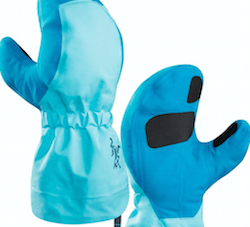
Whilst mittens were once sneered at by serious skiers who considered them only suitable for children and beginners, all this has changed.
Everyone now agrees that they are the warmest hand wear you can buy, particularly for people going off-piste or to ultra-cold climates such as North America’s east coast – but they offer less dexterity.
Which is best: leather or an artificial fabric?
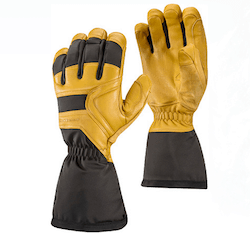
Norrona and Burton both make gloves from lovely soft leather. Black Diamond Men’s Crew Gore-Tex Gloves have goatskin palms, Helly Hansen uses pigskin, whilst 10 Peaks makes gloves and mittens incorporating buffalo leather.
Recycled fabrics
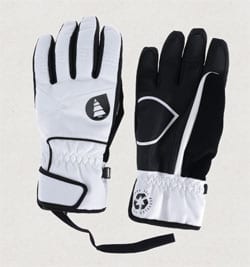
Picture’s designers aim to recover all production off-cuts and raw materials, integrating them into the linings of their ski jackets.
The best insulation and membranes
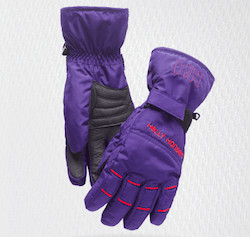
Lots of different insulation fabrics exist, with the leader being PrimaLoft® which is a combination of water-repellent goose down and hydrophobic fibers. It offers the lightweight warmth and comfort of ordinary goose down, but with great wet-weather thermal performance and a faster drying time.
Eider and Salomon both use this type of insulation. EnduraLoft® is another soft, high-loft insulation that is lightweight and recovers well after being compressed.
Waterproofing and drying gloves

Never dry leather gloves palms-down on a radiator overnight – the leather could go hard and lose its suppleness. The same applies to leather in a washing machine. Read the label before attempting to wash or dry any ski gloves or mittens.
Are you an innie or an outie?
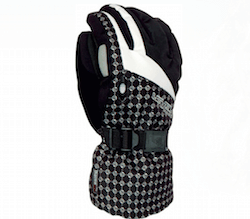
The opposing view is that a glove cuff that fits snugly, closing with Velcro, toggle cords or similar, won’t allow a gap between your jacket cuff and the gloves and therefore any draft.
Adjustable wristbands are far better than elastic ones, and some modern gloves now have safety loops so you won’t loose them if falling in deep snow – or whilst taking a photo from the chair-lift.
Is it worth buying glove liners?
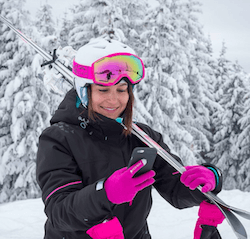
Liners make getting gloves on and off easier and, even though they help you keep warm, they actually help prevent your hands from getting sweaty. They also give you the option to remove your outer gloves to fiddle with your phone or camera, without having to bare your skin.
If you need to be able to text or manage your music regularly on the slopes, you might like to consider liners or undergloves that have ‘touch pads’. Both Dakine and Decathlon make these.
Professional photographers and video-makers should opt for something like the Chaos CTR Mistral Pro Stretch gloves, which are designed for snowshoeing and hiking, but work well for those who want to keep warm yet require plenty of flexibility.
Size doesn’t matter
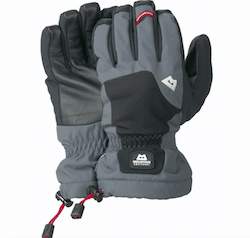
Glove-sizing charts vary from country to country and from brand to brand. However, the main measurement is the circumference of you hand across the widest part – just above the ‘V’ at the base of the thumb. Medium for a woman is 6.5-7.5 inches and for a man 7.5-8.5 inches. Most brands offer extra small to extra large, but the actual size of these classifications may vary considerably.
Sufficient finger length is extremely important – and not only for warmth. Ski gloves take a daily battering from lifts and poles. Make sure that the material at the ‘bottom of the ‘V’ between index finger and thumb rests on the skin and is not too taught. If the material ‘lifts at all when you firmly link the Vs on both hands, then the seams here won’t last the test of time. Within a season, you’ll be reaching for the duct tape.
Which brand is best?
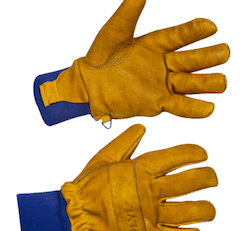
Spend as much as you can sensibly afford and explore the market. Companies like The North Face, Helly Hansen and Scott produce good value technical gloves. Flylow is the glove of choice for a lot of North American ski patrollers – they produce good-value gloves that are warm and waterproof. They have been hand-treated with Sno-Seal beeswax for waterproofing.
Beginners won’t want to go for the most expensive gloves on their first trip, so they would be best off buying mittens and separate liners (see below).
Why are most gloves black?
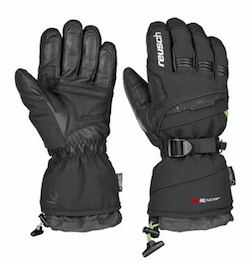
The majority of gloves and mittens still come in black – because it’s a colour that doesn’t show the dirt and it goes with all colours of ski clothing. You can now buy gloves in most colours, although black, sometimes mixed with natural leather, are often the more technical models. Increasingly, though, you can buy gloves to match your ski jacket.
Added extras
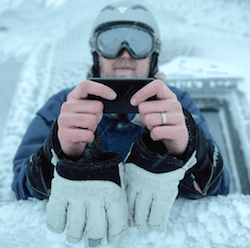
So do Eider, and also 10 Peaks gloves and mittens. The latter also incorporates a goggle wipe and – best of all – a C-ZIP, which is a zip that runs across the top of the gloves, allowing you to easily slip your hands in and out of them without having to take your gloves off altogether. This minimises the risk of losing one when you text from the chair-lift.
Then there are the hybrids, like the ones I have. These are three-finger gloves (sometimes known as lobster mitts) that fall somewhere between gloves and mittens. They give you more dexterity, since not only your thumbs but also your index fingers are separate.
Keeping children’s hands warm
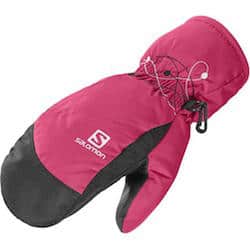
These need to have ribbons attached so that they can be threaded through the arms of their jacket. It lessens the likelihood of losing a glove on the slopes or at the kindergarten.
It is worth bringing a spare pair in case the first one gets soaking wet whilst building snowmen, tobogganing and, of course, skiing. Wet gloves won’t always dry out overnight.
Different gloves for cross-country
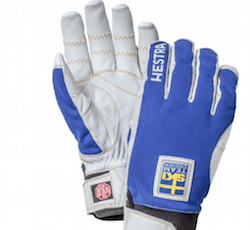
Ergo Grip Active from Hestra is a popular glove for cross-country skiing – it doesn’t have any waterproof membrane on the palms, but the leather is breathable and waterproof.
Is it worth paying extra for heated gloves?
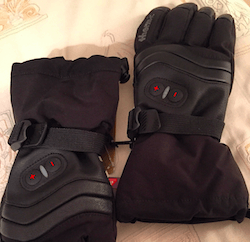
Expect to spend around £200-250 (236-295€) for a pair of heated gloves or mittens. You can recharge the batteries by plugging them in overnight.
They vary in terms of how long the batteries last whilst out on the slopes in severely cold temperatures, so you should consider taking an extra pair of mittens in your backpack…just in case the batteries die during the day.
Kombi makes the Radiator glove, and others include Hestra Power Heater gloves, and Therm-ic Heated gloves. Stores such as Ellis Brigham often stock ranges of them, too.
What to do with your old gloves
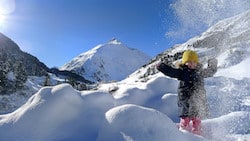
When driving to a resort and putting on snow-chains you’ll need ski gloves that you’re not going to need to wear on the slopes, as they will end up wet and oil-stained.
If all else fails, stick them on a scarecrow. I once knew a hard-drinking ski host (not at Le Ski!) who, whenever it snowed in the springtime, dug into his rucksack held together by duct tape and produced a pair of canary yellow Marigold washing-up gloves. In wet blizzard conditions he swore by them. Waterproofing was never in doubt and warmth was clearly not an issue – I suspect his veins were blood-free.
For more information on accessories, see our features on ski goggles, helmets and socks.
Do you have any favourite gloves or mittens?
We’d be interested to hear any personal recommendations. Let us know in the comments box below.


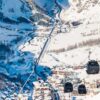
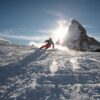









Excellent article – thanks. I just purchased some heated gloves for my wife who really feels the cold – I’m hoping this will make her week much more enjoyable!
Great informative article…..
I’ve got an old pair of red Trespass gloves which are battered, tattered ripped and worn out (a bit like myself lol) but I love them they never let me down, my hands are always warm and dry in them, despite their condition. And they have cords attached so I don’t lose them on the lifts and chairs etc. Will buy a new pair as soon as I can find a suitable replacement in Red!!!!
Having had a lot of recommendations for Hestra gloves I bought a pair and I’m very happy with them – surprised they’re not mentioned more in the article (only briefly on heated bit) as so many people I’ve met swear by them. Any opinion on Hestra generally?
Hi – what’s your opinion of in-built wrist guards? I’ve had a pair of Level mittens for 10 years with this feature and I’m wondering if they do in fact help prevent broken bones… I’m looking for new gloves so wondering if I should seek the same again.
Thanks, Chris
They sound like a good idea Chris – wrist injuries are so common. I’d definitely go for the same again.
The important point is the one regarding core temperature. If your hands/fingers (or feet/toes) are cold, put on an extra layer. The body preserves heat by shutting down circulation to the extremities. Warm body = warm fingers and toes.
Wear a rucksack. Carry extra layers in it. And when you take your gloves off for any reason, tuck them under one of the shoulder straps. In 30 years of skiing this has become instinctive and I’ve never left gloves in a restaurant / lift / hotel / on the end of a pole heading down a hill. And have never needed spare gloves.
Gloves with a zip pocket of the back for a hands-free liftpass are useful.
Gloves with a rubber squeegee on one thumb for clearing snow from goggles are useful.
Gloves with a nice soft bit of fleece on the back of the other thumb for wiping a runny nose are also useful. It’s there for a reason but glove manufacturers don’t mention it. (It might actually be for goggles, but it gets used for my nose)
A long cuff with efficient closure is essential.
My current gloves are Huestra ones. Moderately well-insulated but with separate inners. The cuffs are long and uninsulated with a huge funnel closed by a simple drawstring. They had wrist-straps, but I don’t use them. Squeegee, snot-mop and pass-pocket are also there. I’d like them to have a hide palm but they’re entirely synthetic. Gore-tex, obviously.
There are some good recommendations here. Thank you Martin.
Greetings!
I use two gloves, both I swear by. The first are Hestras Army Mitts (with index finger free). Love ’em! Just need to wax ’em from time to time to keep them supple. Changing the fleece liners are cheap so these gloves will last a lifetime if properly taking care of.
Then I use the Zanier Aviator Heated Gloves. Last year I used them and was very happy with the fit and the longevity of heat, lasted all day, (they are the longest lasting heated gloves among their line). The fit very snug, charging was simple and almost never needed the highest setting.
I should also note I often used heated throwaway pads in my Hestras, (I have cronic cold extremities, used Therm-ic socks and boot liners). This year I’ll give Zippo’s handwarmers a trt
That’s my very happy experience. Hope it helps!
Thomas
Gloves are the most important bit of ski kit to get a correct fit. I insist that they need to “fit like a glove” to coin a phrase. The problem is that so often I can try on a pair and they fail to give a snug fit. I hate fingers being too long, or gloves being too tight. I also hate bulky gloves that are so packed full of insulation that you can’t clench your fist. OK for snowboarding, but not good if you’re expecting to grasp a ski pole.
I use leather gloves, usually mixed with Gortex or insulated with Thinsulate. Currently I’m using Reusch gloves in white and green – yes they do show the dirt but still look cool. And it’s cool seeing downhillers skiers wearing the same gloves – A one-off find in TK Maxx for about £35. Prior to that I used black leather gloves from Salomon and then Spider.
I also carry some light weight breathable gloves for skinning. Similar to lightly insulated cycle gloves. They’ll also serve in an emergency, but not tried them on the downhill. Might be suitable for spring skiing.
A note regarding innie or outie. Unless you’re an instructor or liftie and sporting camel coloured calf-skined, wool-lined gauntlets, it is uncool to wear anything but innies. Ski jacket goes over the cuff.
Spent a fiver on a pair of gloves, at Decathlon, and still use them as a spare pair. Can honestly say they’ve never let me down.
I was recently in France and tried on a pair of Racer Moufle down mittens which were brilliant but they only had large men’s ones in the shop (I need a medium ladies size). Does anyone know where I may be able to get them from? I can’t seem to find them online anywhere at all, let alone find a range of sizes or a ladies equivalent!
Alternatively does anyone know of anything similar? The great things about them was that although they were mittens they also had separate fingers inside them, each insulated. Has anyone come across that in any other brands/models? They were really toasty and I’d love to get hold of some or something similar. Thank you
Should I buy leki or reusch